![]()
Here are some technical shots under the bonnet, for those so
inclined...
Email:
me
Pictures
will take a while to load…
Last
edited Tuesday, January 21,
2014
![]()
Oil filter and oil cooler adapter plate area
![]()
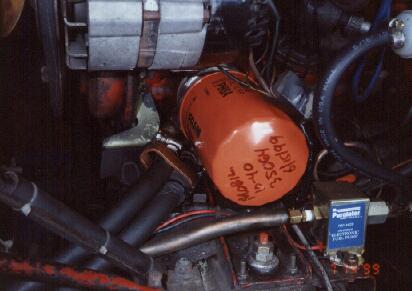
Showing the oil cooler sandwich plate setup,
and fuel pump. That's the top of a Koni shock
absorber, 2 clicks from full soft all around.
The filter shown is a Fram
PH8A filter using the filter adapter from 1147 engine. See this website http://people.msoe.edu/~yoderw/oilfilterstudy/oilfilterstudy.html
for information about oil filters. I just looked through my Fram
PH8A inventory and noticed that 4 had an anti-drainback
flap inside and 2 did not. The one I just took off didn't either, don't know
what the one on there now has. What's the deal here? Frankly, I don’t think it
makes a difference if the engine is off for a few hours or days. The oil drains out anyway when the filter is
in the orientation it is in the Spitfire!
Looks like Fram is
making a poor product now, according to the above webside
comparisons. I'll probably go to Mobil 1 filters (I can’t find these anymore
now in 2005), M1-301 for the PH8A equivalent (or I could use the M1-204
(equivalent to the PH16 Fram some people also use on
Spitfires) I use on the Jeep to simplify inventory), when my stock is depleted.
I am already using Mobil 1 oil and filters on my Jeep Grand Cherokee. Note 2010: I am now using
After seeing the email at bottom of page, I'm
switching filter brands TODAY. I'll probably stick to regular 10-40 oil however
since oil consumption/leakage is about a quart every
I don't understand the purpose of anti drain
back valves in the oil filters, in the long run at least. If you re-start the
engine in a few minutes or hours, I believe the oil filter may retain some of
the oil that was in it at shutdown, but I don't think it stays there all that
much longer. From my experience with this car, the oil seeps down into the
engine in a matter of hours or days by going into the block, thru the oil
gallery and into the crank and then to the block. I've noticed that if I change
the oil soon after a drive, I get a lot of oil out of the filter upon removal.
If I wait a day and change when the engine is cooled down, there's little or
nothing in there.
The oil cooler lines come off the sandwich
plate at 90 degrees. The copper colored item around the lines is a hard copper
alloy to protect the hoses from rubbing through on the motor mount flange on
the front suspension tower. I've also added some tire tape and a piece of
hacksaw blade in that area as the copper was worn about half way through.
The fuel pump is shelf item at Western Auto.
It is the low-pressure unit, Purolator PRO #42S Universal electric fuel pump,
1.5-4
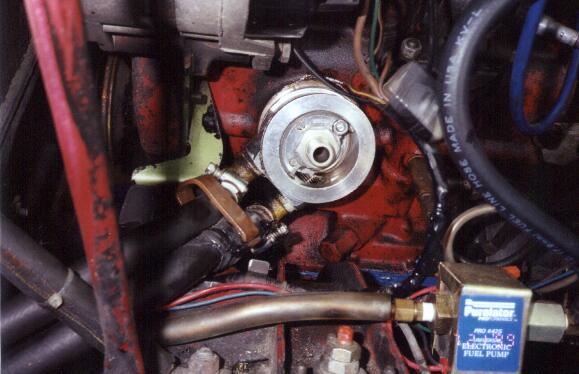
Sandwich plate showing the adapter that
screws it to the threaded oil filter adapter on the block in position. Oil cooler
bypass spring ball-valve (which came apart) has been replaced by 1/4x20 bolt
(see nut ~2:00 on sandwich plate) and nut after it came apart. I figure the oil
cooler won't plug up anyway…
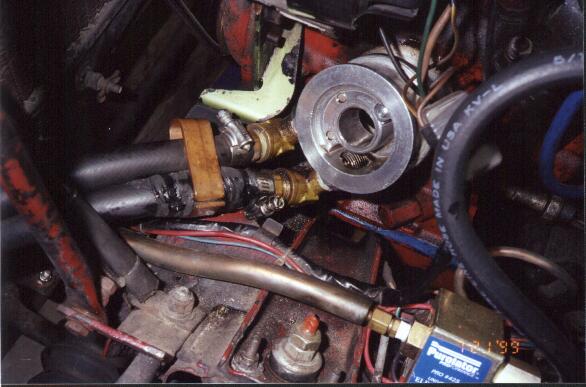
Sandwich plate. Adapter that screws it to the
threaded oil filter adapter on the block is removed.
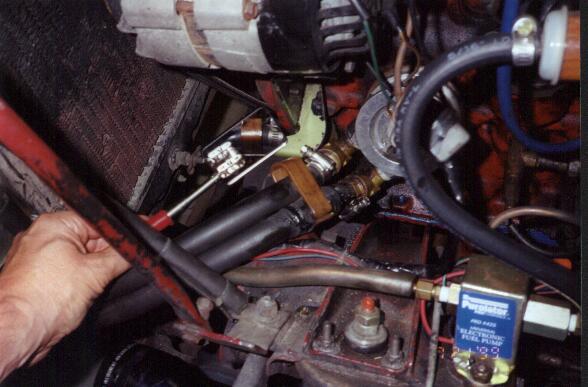
Trying to show the piece of hacksaw blade on
the bottom of the oil cooler hose/copper where it rubs against the suspension
tower. The horizontal line in the mirror is the blade…
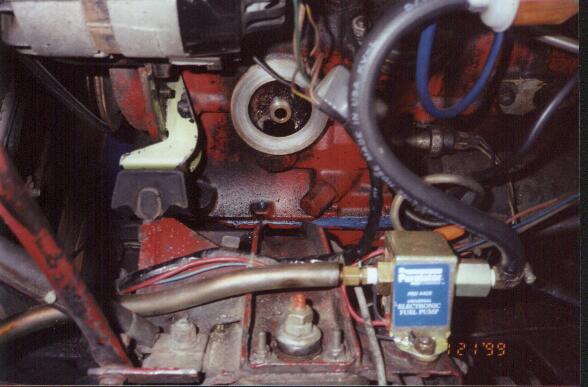
Showing the oil filter adapter. Available
from the Roadster Factory in two different thread configurations depending on
which oil filter you want to use.
![]()
Notes concerning the Fuel Pump location.
![]()
I’ve been told that these fuel pumps are
supposed to be located near the tank and low in the body and that they are
designed to push not suck the gasoline.
Please note that this installation is slightly below or close to the
level of the bottom of the tank and doesn’t need to suction the gas as gravity
takes care of that. I didn’t want to cut
the gas lines in the trunk and mount the pump there or under the floor of the
car where it’s hard to get at when it fails.
I also didn’t want to hear the noise of the pump mounted to the tin
body. The fact that it’s been in this
location for over 20 years with no location related problems (the first one
failed in its late teens as an internal seal started to leak and the gas was
siphoning out during winter storage).
Anyway, I plan to leave it where it is.
It was easy to replace and install the shutoff in this location.
Some information from a SU pump rebuilder’s
website:
“Pusher”
vs. “Puller” fuel pumps
Pusher and/or puller fuel pumps is a
misnomer. Pusher or puller more accurately describes where the pump is mounted.
A pump mounted in the engine compartment is being used as a puller pump in that
it is pulling fuel from the tank, into the engine compartment. Conversely a
pump mounted near the fuel tank is being used as a pusher pump because it
pushing the fuel forward to the engine compartment and the carburetors. Any SU
fuel pump (or any other brand of pump), regardless of whether is low pressure
or high pressure, will generate
http://www.homepages.donobi.net/sufuelpumps/sufuelpumparticles.html
![]()
Tip
![]()
Fuel capacity tip for all you late model
Spitfire owners: Install a early pre-smog gas tank from a MkI
or MkII or MkIII (maybe
early MkIV) with the vented gas cap. It holds a full 10
gallons versus the 9 in yours. Reason being the filler pipe extends into the
tank an inch or so in the late cars leaving an air pocket at the top of the
tank of about 1-gallon capacity for venting to the charcoal canister.
![]()
Email about Fram Filters from Triumph list
![]()
Subj: Fram Oil Filters on the '6
Date: 7/22/99 2:05:52 AM Eastern Daylight
Time
From: garrison@dsl-only.net (The
Garrisons)
Sender: owner-triumphs@autox.team.net
Reply-to: garrison@dsl-only.net (The
Garrisons)
To: triumphs@autox.team.net
CC: rknize@interaccess.com
So I've used Fram filters for years. Many years. Swore
by 'em. Would use nothing else.
Recently visited the web site of the guy who
did the oil filter survey when it was a topic on this list
(http://minimopar.simplenet.com/oilfilterstudy.html). Mr. Knize
did not like Fram oil filters. A bit discouraging,
since his study seemed pretty reasonable and straightforward.
Last week I did an oil change on the '6.
Pulled off the Fram oil filter and... its guts were
sucked up against the face. Probably not good. Had this happened to me before?
Would I have noticed? Or was I just paying attention because of Mr. Knize's study? Who knows.
So now the question is: Who's air filter do I
switch to???
- GeneG
-
![]()
Email:
me
![]()
-----
-----
![]()